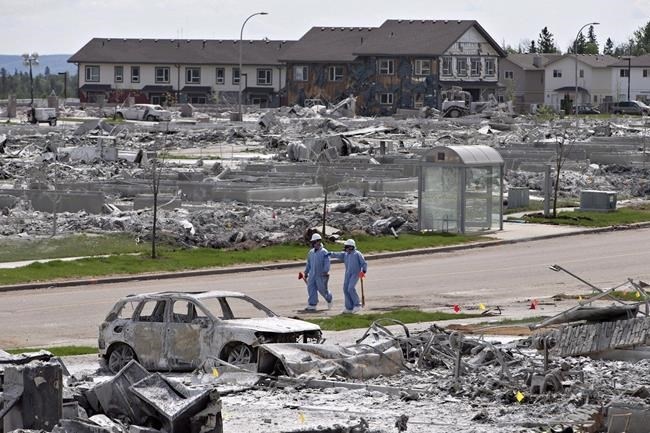
Workers put out markers around a devastated area of Timberlea in Fort McMurray Alta, on Thursday, June 2, 2016. Researchers are finalizing plans to head to Fort McMurray next month to study dust left in homes from the forest fire that ravaged the area last year.
Image Credit: THE CANADIAN PRESS/Jason Franson
June 14, 2017 - 7:00 AM
TORONTO - A group of Ontario researchers is travelling to Fort McMurray, Alta., next month to study dust left in homes from the forest fire that ravaged the city last year.
The team's work is among several studies that are being conducted on the health effects of the ferocious blaze that forced more than 80,000 people to flee.
Arthur Chan, an assistant professor of Chemical Engineering and Applied Chemistry at the University of Toronto, said his team has received overwhelming interest from "concerned" homeowners in Fort McMurray who are offering up their places to be tested.
"We hope we don't find anything," Chan said. "But we're looking for heavy metals and also some organic compounds that are potentially carcinogens. We're going to assess those levels and compare to what we know are normal levels in a home in Canada."
Chan and his team are looking to analyze residual ash from the blaze that consumed 2,400 homes after it hit the city last May.
On July 10, Chan and two of his students will head to Fort McMurray and begin collecting samples from homes in the city and nearby Fort McKay First Nation, which wasn't hit by the fire, but winds blew ash its way.
Chan said he was initially hoping to take samples from 40 places, but residents of 220 homes said they'll open doors to the researchers.
"We will try to go to as many places as we can," he said.
"We will pick up a few samples at each place. We'll try to look at areas that are more accessed, like the living room floor, and then other places that are less frequently cleaned, like the tops of doors."
Chan, who has a background in atmospheric chemistry, first got the idea for the study when he read a news article roughly a month after the wildfire began about people preparing to return to their homes. It got him thinking about the long-term effects of the blaze.
When the Canadian Institutes of Health Research, Alberta Innovates and the Canadian Red Cross put out a call for proposals to look at various health effects in the aftermath of the fire, Chan proposed his research, which won approval and funding from the group along with six other studies.
The other projects are looking at issues that range from the health effects of the blaze on first responders, to the mental health needs of children, to food safety.
Chan said his team will collect samples this summer, again in the fall and a final time next winter and will look to publish the results once their analysis is complete.
They'll also have residents fill out surveys to figure out if an insurance company came and cleaned homes, or if people did the task themselves, and will perform an analysis to see if certain measures led to higher or lower levels of contaminants.
News from © The Canadian Press, 2017